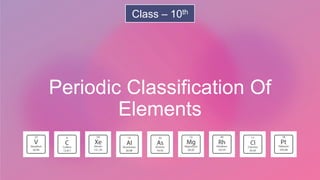
Döbereiner's Triads and Newlands' Law of Octaves
- 1. Class – 10th
- 2. Johann WolfgangDöbereiner • Johann Wolfgang Döbereiner studied as a pharmacist at Münchberg in and then studied chemistry at • Eventually he became a professor of chemistry and pharmacy at the University of Jena. • He made the first observations on platinum as a catalyst and discovered similar triads of elements which led to the development of the Periodic Table elements.
- 3. Döbereiner’s Triads • In the year 1817, Johann Wolfgang Döbereiner, a German chemist, tried to arrange the elements with similar properties into groups. • He identified some groups having three elements each. So, he called these groups ‘Triads’. • Döbereiner showed that when the three elements in a triad were written in the order of increasing atomic masses; the atomic mass of the middle element was roughly the average of the atomic masses of the other two elements. • For e.g., take the triad consisting of Lithium (Li), Sodium (Na) and Potassium (K) with the respective atomic masses 6.9, 23.0 and 39.0.
- 5. John Newlands’ Newlands’ Law Of Octaves.
- 6. Newlands’ Law of Octaves • In 1866, JohnNewlands, arranged the then known elements in the order of increasing atomic masses. • He started with Hydrogenand ended at Thorium which was the 56th element. • Newlands’ found that every eighth element had properties similar to that of the first. • He compared this to the octaves found in music. Therefore, he called it the ‘Law of Octaves’. • In Newlands’ Octaves, the properties of Lithium and Sodium were found to be the same. Sodium is the 8th element after lithium. Similarly, Berylliumand Magnesium resemble each other.
- 8. Limitations Of Octaves • It was found that the Lawof Octaves was applicable only up to Calcium, as after calcium every 8th element did not possess properties similar to that of the 1st. • It was assumed by Newlands that only 56 elements existed in nature and no more elements would be discovered in the future. • But, several new elements were discovered, whose properties did not fit into the Law of Octaves. • In order to fit elements into his table, Newlands adjusted two elements in the same slot, but also put some unlike elements under the same note.
- 9. Mendeleev's Periodic Table Ω The main credit for classifying elements goes to Dmitri Ivanovic Mendeleev, a Russian chemist. Ω He was the most important contributor to the early development of a Periodic Table of elements where in the elements were arranged on the basis of their fundamental property, the atomic mass, and also on the similarity of chemical properties.
- 11. The Beginning… • When Mendeléev started his work, 63 elements were known. He examined the relationship between the atomic masses of the elements and their physical and chemical properties. • Among chemical properties, Mendeléev concentrated on the compounds formed by elementswithoxygen and hydrogen. • He selected hydrogen and oxygen as they are very reactive and formed compounds with most elements. • The formulae of the hydrides and oxides formed by an element were treated as one of the basic properties of an element for its classification.
- 12. Old Periodic Law • He observed that most of the elements got a place in a Periodic Table and were arranged in the order of their increasing atomic masses. • It was also observed that there occurs a periodic recurrence of elements with similar physical and chemical properties. • Mendeléev’s Periodic Table contains vertical columns called ‘Groups’ and horizontal rows called ‘Periods’. Mendeléev formulated a Periodic Law, which states that ‘the properties of elements are the periodic function of their atomic masses’.
- 14. Limitations Of Mendeleev's Table • Electronic configuration of hydrogen resembles that of alkali metals. • Like alkali metals, hydrogen combines with halogens, oxygen and sulphur to form compounds having similar formulae. • Just like halogens, hydrogen also exists as diatomic molecules and it combines with metals metals and non-metals to form covalent compounds. • Certainly, no fixed position can be given to hydrogen in the Periodic Table, this was the 1st
- 15. The Modern Periodic Table • In 1913, HenryMoseley showed that the atomic numberof an element is a more fundamental propertythan its atomic mass. Accordingly, Mendeléev’s Periodic Law was modified as the basis of Modern Periodic Table and the Modern Periodic Law can be stated as follows: • ‘Properties of elements are a periodic function of their atomic number.’ • Elements, when arranged in order of increasing atomic number Z, lead us to the classification known as the Modern Periodic Table.
- 17. Position of Elements • The ModernPeriodicTablehas18 verticalcolumns known as ‘Groups’ and 7 horizontalrowsknown as ‘Periods’. • Each period marks a new electronic shell getting filled. • The maximum number of electrons that can be accommodated in a shell by 𝟐𝒏𝟐. K Shell – 2 × (1)2 = 2, hence the first period has 2 elements. L Shell – 2 × (2)2 = 8, hence the second period has 8 elements. M Shell – 2 × (3)2 = 18, but the outermost shell can have only 8 electrons, so the third period also has only 8 elements. • Thepositionof anelementinthePeriodicTabletellsusaboutitschemicalreactivity.
- 18. Periodic Trends VALENCY It is determined by the number of valence electrons present in the outermost shell of its atom. ATOMIC SIZE It refers to the radius of an atom. The atomic radius of hydrogen atom is 1 pm = 𝟏𝟎−𝟏𝟐 m. • It decreases across a period and increases down the group. • Due to gain in nuclear charge. METALS They tend to lose electrons while forming bonds, because they are Electropositive in nature. For e.g. Na, Mg, Ca, etc. METALLOIDS Elements such as Boron, Silicon, Germanium, etc. show intermediate properties and are called Metalloids. NON – METALS Non-metals are Electronegative. They tend to form bonds by gaining electrons.
- 19. Thank You!